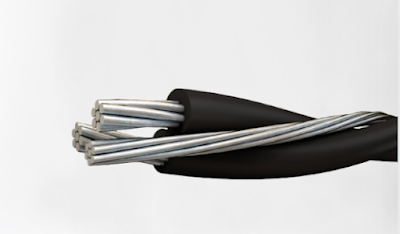Difference Between HV and MV Cables and their uses?
Voltage, also known as electric potential difference, is classified into different categories based on the level of electric potential difference or voltage:
Low Voltage (LV): Voltage level up to 1000 AC or 1500 DC. Used in residential, commercial, and light industrial applications for power distribution and control.
Medium Voltage (MV): Voltage level between 1000V and 35,000V AC. Used in power distribution and transmission networks, industrial applications, and underground power systems.
High voltage (HV): Voltage level between 35,000 to 230,000 volts AC. Used in long distance power transmission networks, electric power generation, and high voltage industrial applications.
Extra High Voltage (EHV): Voltage level above 230,000 volts AC Used in power transmission networks for long-distance power transmission, and for interconnecting regional power grids.
Ultra High Voltage (UHV): Voltage level above 800 kV AC Used in long-distance power transmission networks for reducing power losses during transmission.
What is a high voltage cable?
In order to transport electrical energy at voltages greater than 35 kV, high voltage (HV) cables are used.
They are frequently used in networks for the transmission and distribution of electrical energy, linking power plants to substations or substantial industrial customers.
HV cables are also utilized in underground tunnelling operations, offshore wind farms, and the linking of various grids.
HV cables have multiple insulation layers, including a metallic conductor, a semiconducting shield, an insulation layer, and an outer sheath to guard against moisture and mechanical harm.
Specifications of HV cable can differ among HV cable suppliers.
What is a Medium Voltage (MV) Cable?
Electrical energy can be transmitted via medium voltage (MV) cables at voltages between 1 kV and 35 kV.
They are frequently used in power distribution networks, underground cables, industrial applications, and the connection of transformers to switchgear.
In addition, MV (Medium Voltage) cables are utilized in infrastructure projects including highway, airport, and rail construction.
The standard construction of MV cables includes copper or aluminium conductors, cross-linked polyethylene (XLPE) insulation, and an outer sheath for mechanical and moisture protection.
Many MV and HV cable suppliers use a different design for their cable to meet your requirements.
Key differences between high voltage and medium voltage cables
High Voltage (HV) Cable
1. Designed to transmit electrical energy at voltages higher than 35 kV.
2. Used in power transmission and distribution networks, connecting power stations to substations, or to large industrial consumers.
3. Used for interconnections between different grids, offshore wind farms, and underground tunneling projects.
4. Made of several layers of insulation, including a semiconducting shield, a metallic conductor, an insulation layer, and an outer sheath.
5. MV cables are generally larger in size and have thicker insulation layers to withstand the higher voltage levels.
Medium Voltage (MV) Cable
1. Designed to transmit electrical energy at voltages ranging from 1 kV to 35 kV.
2. Used in power distribution networks, connecting transformers to switchgear, underground cables, and in industrial applications.
3. Used in infrastructure projects such as railways, airports, and highways.
4. Typically made of copper or aluminum conductors with a cross-linked polyethylene (XLPE) insulation and an outer sheath.
5. Used for local distribution networks and industrial applications at lower voltage levels.
Uses of High Voltage (HV) Cable
High voltage (HV) cables are primarily used in power transmission and distribution networks to transmit electrical energy at voltages higher than 35 kV. Some of the specific uses of HV cables are:
1. Connecting power stations to substations: HV cables are used to connect power stations to substations, where the electrical energy is transformed to lower voltages for local distribution networks.
2. Interconnecting different grids: HV cables are used to interconnect different grids, allowing for the transfer of electrical energy between different regions or countries.
3. Offshore wind farms: HV cables are used to connect offshore wind farms to the mainland power grid.
4. Underground tunnelling projects: HV cables are used in underground tunneling projects, such as subways, to provide power for the trains and other equipment.
5. Large industrial consumers: HV cables are used to supply power to large industrial consumers, such as factories and refineries.
Uses of Medium Voltage Cable
Medium Voltage (MV) cables are used for power distribution networks that operate at voltage levels between 1 kV and 35 kV. Some of the specific uses of MV cables are:
1. Connecting distribution transformers: MV cables are used to connect distribution transformers to the main power supply, allowing for the distribution of electrical energy at lower voltages to residential and commercial consumers.
2. Powering street lighting: MV cables are used to power street lighting systems, which typically operate at voltage levels between 3 kV and 12 kV.
3. Underground power distribution: MV cables are commonly used for underground power distribution networks where overhead lines are not feasible due to aesthetic, safety, or environmental reasons.
4. Industrial applications: MV cables are used in industrial settings, where they can provide power to large motors and other electrical equipment.
5. Renewable energy systems: MV cables are used in renewable energy systems, such as solar and wind farms, to transmit the generated power to the grid.
Final Thoughts
HV cables are used for long-distance power transmission at high voltage levels, while MV cables are used for local distribution networks and industrial applications at lower voltage levels.
We at Znergy Cable are the best HV cable suppliers and MV cable manufacturers in Australia. we manufacture Low Voltage to High Voltage and any specialist cables in Mining, Fire, LSZH, Shipping, Instrumentation, Oil & Petro-chemical, Gas, Solar, Undersea submersible and industrial cables.
Visit also:
https://znergycableaustralia.blogspot.com/2024/03/what-is-copper-armored-cable-current.html
https://znergycableaustralia.blogspot.com/2024/03/how-are-capillary-tubes-made.html
https://znergycableaustralia.blogspot.com/2024/03/what-is-4-0-triplex-underground-wire.html
https://znergycableaustralia.blogspot.com/2024/03/what-is-3-core-16mm-armoured-cable.html
https://znergycableaustralia.blogspot.com/2024/03/what-are-type-2s-cable-ties.html
https://znergycableaustralia.blogspot.com/2024/03/how-does-capillary-tube-work-in.html
https://znergycableaustralia.blogspot.com/2024/03/difference-between-mv-cable-and-hv-cable.html
https://znergycableaustralia.blogspot.com/2024/03/what-safety-features-does-type-409.html
https://znergycableaustralia.blogspot.com/2024/03/when-to-use-heat-resistant-cables.html
https://znergycableaustralia.blogspot.com/2024/02/type-450-cable-in-australia.html




Comments
Post a Comment